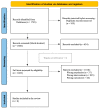The Effectiveness of Paired Associative Stimulation on Motor Recovery after Stroke: A Scoping Review
- PMID: 38804482
- PMCID: PMC11130975
- DOI: 10.3390/neurolint16030043
The Effectiveness of Paired Associative Stimulation on Motor Recovery after Stroke: A Scoping Review
Abstract
Paired associative stimulation (PAS) is a non-invasive brain stimulation technique combining transcranial magnetic stimulation and peripheral nerve stimulation. PAS allows connections between cortical areas and peripheral nerves (C/P PAS) or between cortical regions (C/C PAS) to be strengthened or weakened by spike-timing-dependent neural plasticity mechanisms. Since PAS modulates both neurophysiological features and motor performance, there is growing interest in its application in neurorehabilitation. We aimed to synthesize evidence on the motor rehabilitation role of PAS in stroke patients. We performed a literature search following the PRISMA Extension for Scoping Reviews Framework. Eight studies were included: one investigated C/C PAS between the cerebellum and the affected primary motor area (M1), seven applied C/P PAS over the lesional, contralesional, or both M1. Seven studies evaluated the outcome on upper limb and one on lower limb motor recovery. Although several studies omit crucial methodological details, PAS highlighted effects mainly on corticospinal excitability, and, more rarely, an improvement in motor performance. However, most studies failed to prove a correlation between neurophysiological changes and motor improvement. Although current studies seem to suggest a role of PAS in post-stroke rehabilitation, their heterogeneity and limited number do not yet allow definitive conclusions to be drawn.
Keywords: neurophysiology; neurorehabilitation; non-invasive brain stimulation (NIBS); paired associative stimulation (PAS); plasticity; stroke.
Conflict of interest statement
The authors declare no conflicts of interest.
References
-
- Ahmed I., Mustafaoglu R., Rossi S., Cavdar F.A., Agyenkwa S.K., Pang M.Y.C., Straudi S. Non-Invasive Brain Stimulation Techniques for the Improvement of Upper Limb Motor Function and Performance in Activities of Daily Living After Stroke: A Systematic Review and Network Meta-Analysis. Arch. Phys. Med. Rehabil. 2023;104:1683–1697. doi: 10.1016/j.apmr.2023.04.027. - DOI - PubMed
Publication types
Grants and funding
LinkOut - more resources
Full Text Sources
Miscellaneous


